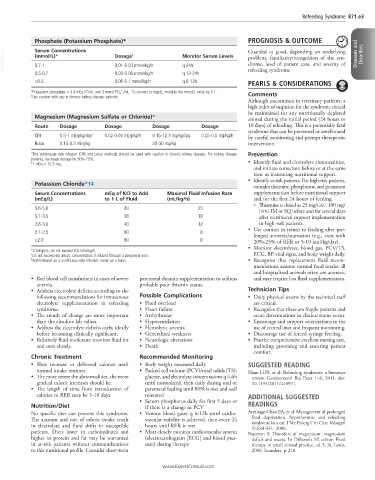Page 1735 - Cote clinical veterinary advisor dogs and cats 4th
P. 1735
Refeeding Syndrome 871.e3
Phosphate (Potassium Phosphate)* PROGNOSIS & OUTCOME
VetBooks.ir Serum Concentrations Dosage † Monitor Serum Levels Guarded to good, depending on underlying Diseases and Disorders
(mmol/L)*
problem, familiarity/recognition of the syn-
drome, level of patient care, and severity of
q 24h
0.7-1
0.01-0.03 mmol/kg/h
0.5-0.7 0.03-0.06 mmol/kg/h q 12-24h refeeding syndrome
<0.5 0.06-0.1 mmol/kg/h q 6-12h PEARLS & CONSIDERATIONS
2−
+
*Potassium phosphate = 4.4 mEq K /mL and 3 mmol PO 4 /mL. To convert to mg/dL, multiply the mmol/L value by 3.1. Comments
† Use caution with use in chronic kidney disease patients.
Although uncommon in veterinary patients, a
high index of suspicion for the syndrome should
be maintained for any nutritionally depleted
Magnesium (Magnesium Sulfate or Chloride)* animal during the initial period (24 hours to
Route Dosage Dosage Dosage Dosage 10 days) of refeeding. This is a potentially fatal
syndrome that can be prevented or ameliorated
CRI 0.5-1 mEq/kg/day † 0.02-0.04 mEq/kg/h 6.15-12.3 mg/kg/day 0.25-0.5 mg/kg/h by careful monitoring and prompt therapeutic
Bolus 0.15-0.3 mEq/kg 20-30 mg/kg intervention.
*The continuous-rate infusion (CRI) and bolus methods should be used with caution in chronic kidney disease. For kidney disease Prevention
patients, decrease dosage by 50%-75%.
† 1 mEq = 12.3 mg, • Identify fluid and electrolyte abnormalities,
and initiate correction before or at the same
time as instituting nutritional support.
• Identify at-risk patients. For high-risk patients,
Potassium Chloride*†‡ consider thiamine, phosphorus, and potassium
Serum Concentrations mEq of KCl to Add Maximal Fluid Infusion Rate supplementation before nutritional support
(mEq/L) to 1 L of Fluid (mL/kg/h) and for the first 24 hours of feeding.
○ Thiamine is dosed as 25 mg/CAT, 100 mg/
3.6-5.0 20 25
DOG IM or SQ before and for several days
3.1-3.5 28 18 after nutritional support implementation
2.6-3.0 40 12 in high-risk patients.
• Use caution in return to feeding after pro-
2.1-2.5 60 8
longed anorexia/starvation (e.g., start with
<2.0 80 6 20%-25% of RER or 5-10 kcal/kg/day).
• Monitor electrolytes, blood gas, PCV/TS,
*2 mEq/mL; do not exceed 0.5 mEq/kg/h.
† Do not exceed 60 mEq/L concentration if infused through a peripheral vein. ECG, BP, vital signs, and body weight daily.
‡ Administered as a continuous-rate infusion, never as a bolus. • Recognize that replacement fluid recom-
mendations assume normal food intake; ill
and hospitalized animals often are anorexic
• Red blood cell transfusions in cases of severe parenteral thiamin supplementation to address and may require less fluid supplementation.
anemia probable poor thiamin status.
• Address electrolyte deficits according to the Technician Tips
following recommendations for intravenous Possible Complications • Daily physical exams by the technical staff
electrolyte supplementation in refeeding • Fluid overload are critical.
syndrome. • Heart failure • Recognize that these are fragile patients and
• The trends of change are more important • Arrhythmias acute deteriorations in clinical status occur.
than the absolute lab values. • Hypoventilation • Encourage and support veterinarians in the
• Address the electrolyte deficits early, ideally • Hemolytic anemia use of central lines and frequent monitoring.
before becoming clinically significant. • Generalized weakness • Discourage use of forced syringe feeding.
• Relatively fluid intolerant: monitor fluid ins • Neurologic alterations • Practice comprehensive excellent nursing care,
and outs closely. • Death including grooming and ensuring patient
comfort.
Chronic Treatment Recommended Monitoring
• Slow increase in delivered calories until • Body weight measured daily SUGGESTED READING
normal intake resumes. • Packed cell volume (PCV)/total solids (TS), Khan LUR, et al: Refeeding syndrome: a literature
• The more severe the abnormalities, the more glucose, and electrolyte concentrations q 4-6h review. Gastroenterol Res Pract 1–6, 2011. doi:
gradual caloric increases should be. until normalized, then daily during oral or 10.1155/2011/410971.
• The length of time from introduction of parenteral feeding until RER is met and well
calories to RER may be 5-10 days. tolerated ADDITIONAL SUGGESTED
• Serum phosphorus daily for first 5 days or
Nutrition/Diet if there is a change in PCV READINGS
No specific diet can prevent this syndrome. • Venous blood gases q 6-12h until cardio- Armitage-Chan EA, et al: Management of prolonged
The amount and rate of caloric intake result vascular stability is achieved, then every 24 food deprivation, hypothermia, and refeeding
in electrolyte and fluid shifts in susceptible hours until RER is met syndrome in a cat. J Vet Emerg Crit Care 16(suppl
1):S34-S41, 2006.
patients. Diets lower in carbohydrates and • Must closely monitor cardiovascular system Bateman S: Disorders of magnesium: magnesium
higher in protein and fat may be warranted (electrocardiogram [ECG] and blood pres- deficit and excess. In DiBartola SP, editor: Fluid
in at-risk patients without contraindications sure) during therapy therapy in small animal practice, ed 3, St. Louis,
to this nutritional profile. Consider short-term 2006, Saunders, p 210.
www.ExpertConsult.com

